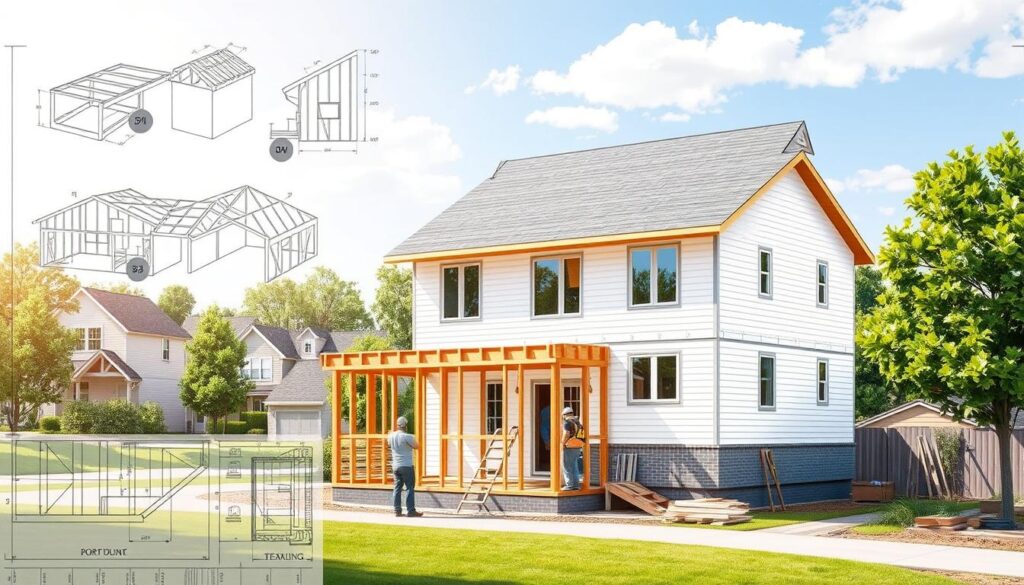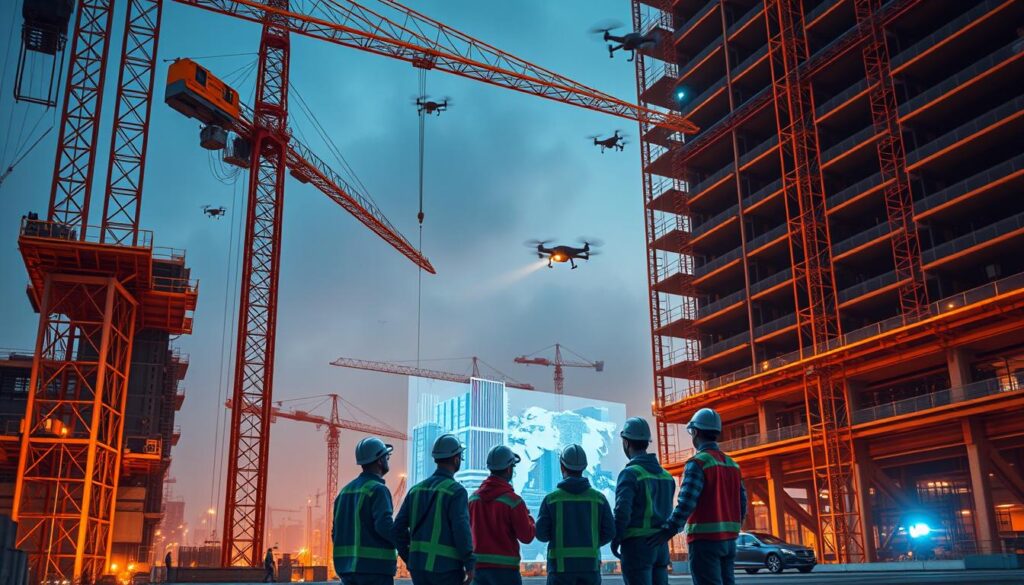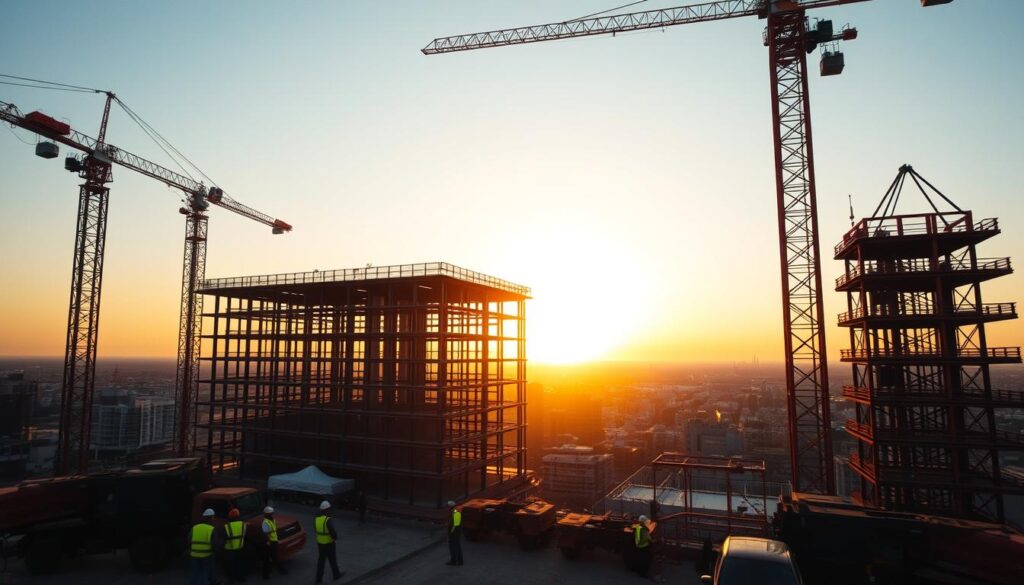The construction industry is a key part of our world. It builds everything from big skyscrapers to homes. These fields are full of specialized work that turns ideas into real buildings.
People in the construction world are very important. They help make our places to live better and grow our economy. Knowing about the different parts of the industry shows us the hard work and creativity behind each project.
Looking into the construction industry, we see a world of skills and technology. Each area brings its own special talents. Together, they create amazing spaces that meet our needs today.
Key Takeaways
- Construction industry spans multiple specialized sectors
- Professionals transform architectural designs into physical structures
- Building sectors require diverse technical and creative skills
- Infrastructure development drives economic progress
- Technological innovation continues to reshape construction practices
Overview of the Modern Construction Industry
The modern construction industry is always changing and shaping our world. It’s a mix of people, technology, and new ways of building. This mix helps create the buildings and roads we use every day.
In recent years, the construction world has changed a lot. New tech and shifts in the economy have made it more efficient and advanced.
Evolution of Construction Practices
Building methods have changed a lot thanks to technology. Some big changes include:
- Digital design and 3D modeling technologies
- Prefabrication and modular construction techniques
- Advanced materials with enhanced durability
- Automated machinery and robotics
Current Market Trends and Statistics
The construction industry is growing fast. It’s seeing big increases in areas like infrastructure and homes.
Some important stats show:
- Global construction market expected to reach $14.4 trillion by 2025
- Emerging markets driving significant investment
- Increasing focus on sustainable building practices
Impact on Global Economy
Construction’s impact goes beyond just buildings. It’s a key part of the economy, creating jobs and pushing tech forward in many fields. It affects industries like manufacturing and tech all over the world.
By using the latest tech and green building, construction is changing how we live and interact with our surroundings.
Core Construction Management Principles
Construction management is key to successful building projects. It combines important strategies to turn designs into real buildings. At its heart, it needs a detailed plan and smart use of resources.
Construction management focuses on a few main areas:
- Strategic project planning
- Efficient resource allocation
- Risk management
- Quality control processes
- Communication optimization
Project planning starts with a deep analysis and strategic planning. Managers create detailed plans that foresee problems and offer flexible ways to solve them. Accurate scheduling is vital to keep projects on time and within budget.
Resource allocation is also very important. It involves smartly using labor, equipment, and materials to boost productivity and cut down on waste. This needs advanced tracking systems and quick decision-making.
Today’s construction management uses new technologies to improve accuracy and efficiency:
- Digital project management software
- Advanced scheduling algorithms
- Real-time communication platforms
- Predictive analytics tools
Good construction managers are flexible. They keep an eye on how the project is going, make changes based on data, and talk openly with everyone involved. This helps ensure the best results.
FIELDS INVOLVED IN CONSTRUCTION
The construction industry has many specialized fields working together. They turn architectural dreams into real buildings. Each field is key to making buildings safe, useful, and new.
Construction projects need teamwork between different fields. This teamwork makes sure projects go from idea to reality smoothly.
Architectural Design and Planning
Architectural design is the creative start of construction projects. Architects make detailed plans that look good and work well. Their jobs include:
- Creating detailed building schematics
- Evaluating spatial relationships
- Developing innovative design solutions
- Ensuring compliance with local building regulations
Civil Engineering and Structural Work
Civil engineering makes sure buildings are stable and strong. They check the ground, design strong parts, and make sure buildings can handle weather.
| Civil Engineering Focus Areas | Primary Responsibilities |
|---|---|
| Foundation Design | Analyzing soil mechanics and structural support |
| Structural Analysis | Calculating load capacities and material strengths |
| Infrastructure Planning | Developing comprehensive site development strategies |
Mechanical and Electrical Systems
MEP systems make buildings work well and feel good. They include mechanical, electrical, and plumbing techs. These systems are key for modern buildings.
- Mechanical systems manage heating, ventilation, and air conditioning
- Electrical systems provide power distribution and lighting solutions
- Plumbing systems ensure water management and waste removal
Each field in construction brings its own skills. They work together to make amazing buildings from ideas.
Residential Construction Specializations

Home building is a complex field in the construction world. It covers many types of projects, from single homes to big apartment buildings. Each project needs special skills, careful planning, and new design ideas.
Experts in home building focus on a few main areas:
- Single-family home construction
- Multi-family residential developments
- Custom home design and implementation
- Renovation and remodeling projects
Building custom homes requires a lot of detail. Architects and builders work together to make clients’ dreams come true. Personalization is key in successful home projects, making each home unique to its owner’s needs.
| Construction Type | Average Project Duration | Complexity Level |
|---|---|---|
| Single-Family Homes | 4-8 months | Moderate |
| Multi-Family Residential | 12-24 months | High |
| Custom Home Building | 6-12 months | Very High |
Today’s home building uses new tech and green practices. Things like saving energy, smart homes, and green materials are important. They make homes better for the planet and more comfortable for people.
Commercial and Industrial Construction Sectors
The commercial construction world is always changing and very important. It shapes cities and boosts the economy in the United States. Buildings like skyscrapers and big industrial sites show off amazing engineering and design.
Commercial construction includes many types of projects. They need special skills and careful planning. These projects can be anything from tall buildings to big industrial sites for making things and tech.
High-rise Development Challenges
High-rise buildings are the top of city design. They need top engineering and new building methods. Important things to think about include:
- Structural strength and how they handle wind
- Complex foundation systems
- New materials
- Smart systems for electricity and water
Industrial Facility Construction
Industrial buildings need special designs for working well. Today’s industrial building focuses on making spaces that can change and help new tech and ways of making things.
| Project Type | Key Characteristics | Average Construction Time |
|---|---|---|
| Manufacturing Facilities | Special equipment areas | 12-18 months |
| Logistics Centers | High ceilings | 9-15 months |
| Research Complexes | Latest tech setup | 18-24 months |
Retail and Office Space Development
Commercial building is now all about flexible designs. Modern shops and offices use tech, green ideas, and design that puts people first.
“Commercial construction is not just about building structures, but creating environments that inspire productivity and innovation.” – Architecture Design Magazine
Good commercial building projects mix skills, looks, and usefulness. They meet the changing needs of businesses and cities.
Infrastructure and Heavy Civil Construction
Infrastructure projects are the heart of our modern world. They drive economic growth and make life better. Civil engineering is key in building these public works that shape our world.
These big projects need top skills, smart planning, and creative solutions.
Key infrastructure projects include:
- Transportation networks like highways and bridges
- Water management systems
- Power generation facilities
- Large-scale urban development projects
Heavy civil construction is complex. It needs special skills and the latest tech. Engineers face big challenges like:
- Environmental impact assessments
- Geological terrain analysis
- Advanced materials selection
- Sustainable design integration
| Project Type | Average Duration | Estimated Cost Range |
|---|---|---|
| Highway Construction | 3-5 years | $5-50 million |
| Bridge Development | 2-4 years | $10-100 million |
| Urban Infrastructure | 4-7 years | $20-500 million |
Modern infrastructure projects keep pushing tech limits, changing how communities live and grow. Civil engineers lead in making sustainable, efficient public works. They meet society’s big needs.
Sustainable Building Practices and Green Construction
The construction world is changing fast, moving towards green building. This shift aims to lessen environmental harm and build better, more efficient structures. Sustainable construction uses new design methods to cut down on carbon emissions and use resources wisely.
Today, builders focus more on green methods that meet global sustainability targets. It’s not just about saving energy. It’s about a full approach to design and choosing materials.
Energy-Efficient Design Methods
New sustainable building techniques aim to improve energy use through:
- Advanced insulation technologies
- Solar panel integration
- Smart building management systems
- Passive heating and cooling strategies
Environmental Impact Assessment
Green building now includes detailed environmental checks. These checks look at:
- Carbon emissions potential
- Resource consumption
- Long-term ecological implications
- Waste reduction strategies
Green Building Certification
LEED certification is the top honor in green building. The U.S. Green Building Council created it. It checks buildings on many green criteria, pushing developers to use the latest green strategies.
“Sustainable construction is not just a trend, it’s the future of responsible building design.” – Green Building Expert
By adopting these new methods, the construction field is making buildings that are stronger, more efficient, and better for the environment. These buildings help both people and the planet.
Technology and Digital Innovation in Construction

The construction industry is changing fast thanks to digital innovation. New technology is making project planning and execution more efficient and precise. This is a big change for building projects.
Building Information Modeling (BIM) is leading this tech change. It lets architects, engineers, and contractors create detailed 3D models of projects. These models include all parts of a project. BIM helps teams:
- See complex building systems clearly
- Find problems before they start
- Use resources better
- Lower the cost of mistakes
New tech is also making a big impact. Drones are now used for real-time site monitoring. They take detailed aerial photos and track project progress accurately.
| Technology | Key Benefits | Industry Impact |
|---|---|---|
| BIM | Integrated design, conflict resolution | Improved project coordination |
| Drone Surveying | Rapid site mapping, safety inspections | Enhanced monitoring capabilities |
| 3D Printing | Rapid prototyping, custom components | Reduced material waste |
Smart building systems are another big step forward. They use sensors and controls to improve building performance. They manage things like energy use and environmental conditions with great accuracy.
As digital innovation grows, the construction industry is getting better. It’s becoming more efficient, sustainable, and advanced. People who use these new tools are leading the way in this changing field.
Safety Standards and Regulatory Compliance
Understanding construction safety means knowing the rules and quality checks. Workers must protect themselves and follow strict rules to keep everyone safe.
The construction world has strict rules to reduce risks and improve project results. Following these rules is not just legal. It’s also key to managing projects well.
OSHA Requirements: Protecting Workplace Safety
The Occupational Safety and Health Administration (OSHA) sets clear safety rules for construction. These rules cover many important areas:
- Personal protective equipment (PPE) standards
- Fall protection protocols
- Equipment maintenance requirements
- Hazardous material handling procedures
Building Codes and Permit Processes
Building rules are key for quality and safety in construction. Contractors must go through detailed permit processes. These processes check if projects meet local and national standards.
“Safety is not an accident, but a deliberate and continuous commitment.” – Construction Safety Expert
Quality Control Measures
Good quality control means checking and documenting work as it’s done. Important steps include:
- Regular site inspections
- Material testing protocols
- Comprehensive documentation
- Third-party verification processes
Strong quality control steps help avoid risks and make projects successful.
Conclusion
The construction industry is full of life and change, offering many career paths. It covers areas like architectural design and sustainable building. People with technical skills and flexibility can easily start their careers here.
Learning new skills is key to doing well in construction today. New tech like digital models and green building methods are changing the job scene. Those who keep learning and try new things will lead the way in the industry.
The construction world is set to grow, with more projects and tech use. Whether you’re into homes, offices, or big projects, there’s a place for you. To grow, you need to know many things, keep up with tech, and focus on quality.
Construction is a broad field with lots of chances for growth. It’s perfect for students, new grads, or those looking to change careers. By exploring different areas and staying open to change, you can build a fulfilling career that makes a difference.

